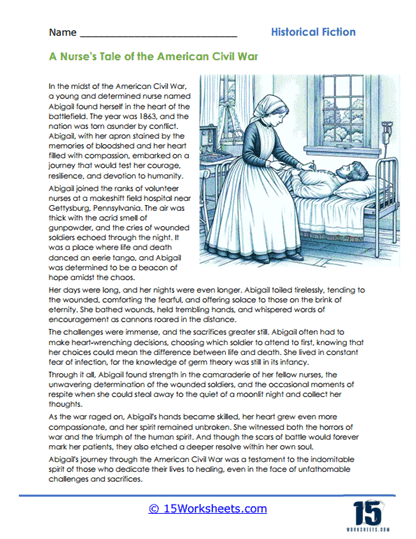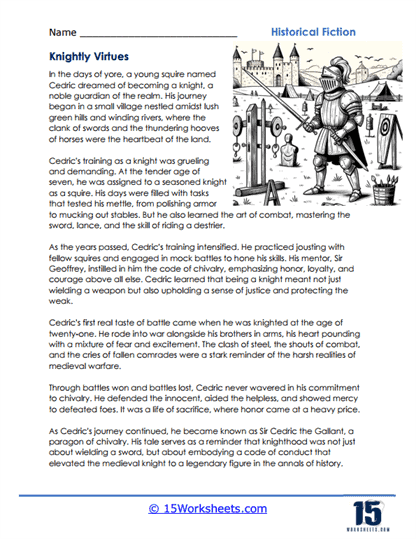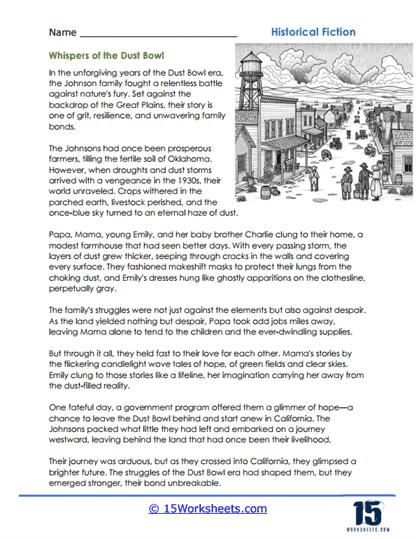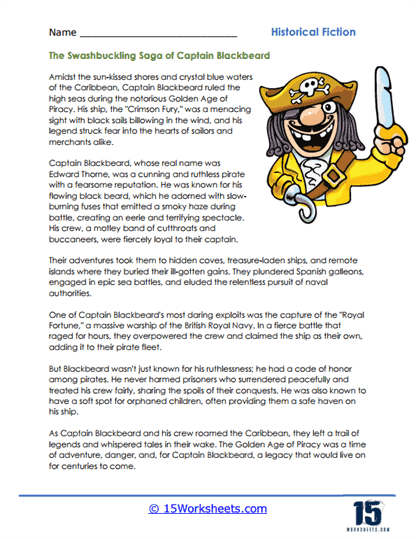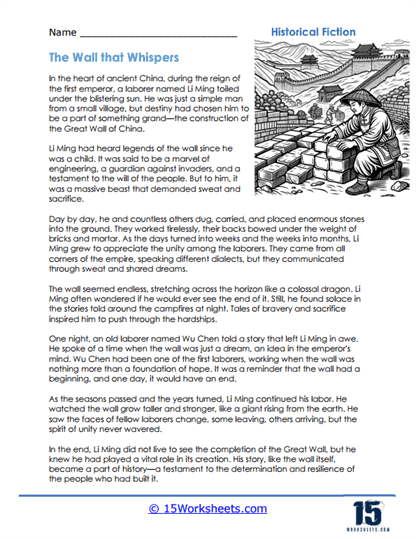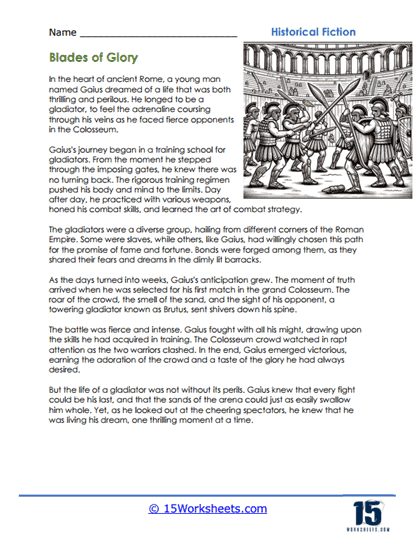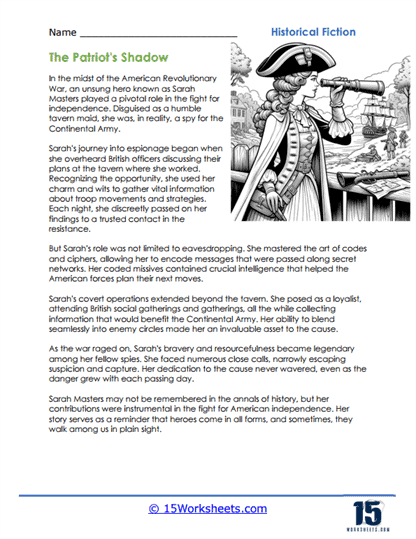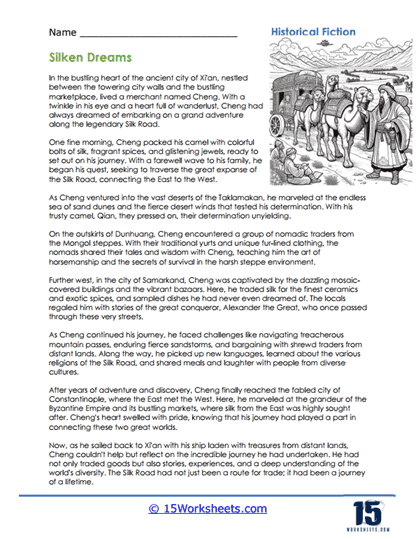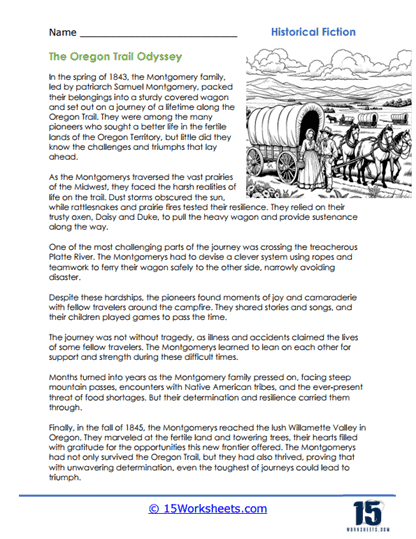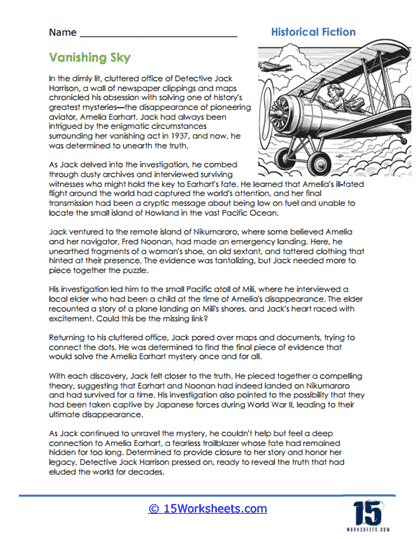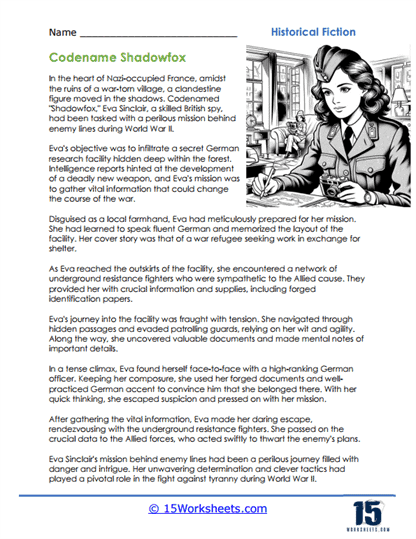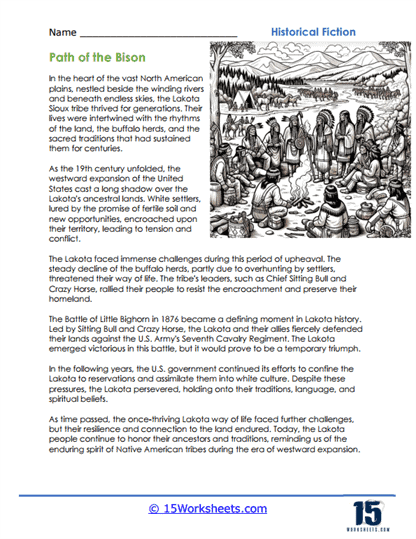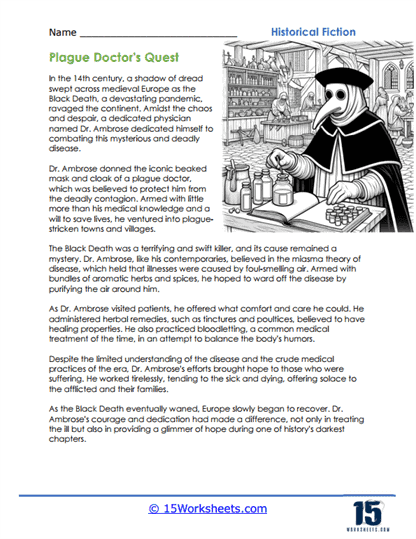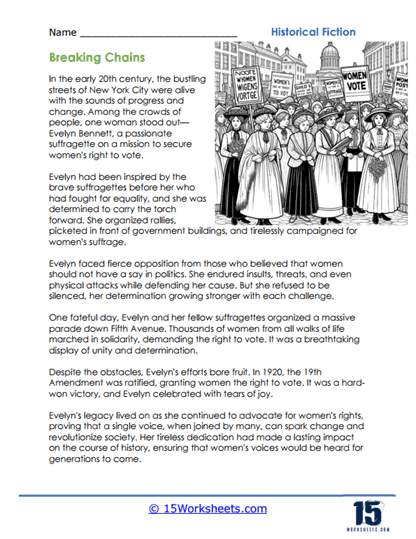Historical Fiction Worksheets
About These 15 Worksheets
Historical fiction worksheets are educational tools designed to enhance the learning experience for students engaging with historical fiction literature. These worksheets combine elements of history and fiction, offering a variety of exercises to deepen understanding and appreciation of the historical context, characters, and narrative. In this detailed exploration, we’ll delve into the types of exercises found on these worksheets and how they can bolster students’ reading comprehension and analytical skills.
These worksheets provide a structured approach to exploring the rich tapestry of historical narratives, ensuring that students not only understand what they read but also appreciate the intricate interplay between history and fiction.
Types of Exercises on These Worksheets
1. Contextual Analysis Exercises
Historical Setting Identification: Students identify the historical period and setting of the story. This involves researching the era, understanding its significance, and relating it to the narrative.
Fact vs. Fiction: Exercises that encourage students to differentiate between historical facts and fictional elements in the story. This enhances critical thinking and research skills.
2. Character Analysis Exercises
Character Profiles: Focusing on the main characters, these exercises ask students to analyze their backgrounds, motivations, and development throughout the story.
Historical Figures Comparison: In stories featuring real historical figures, students compare the fictional portrayal with actual historical records.
3. Plot Analysis Exercises
Timeline Creation: Students create timelines that align the plot with historical events. This helps in understanding how the narrative fits within the historical context.
Cause and Effect Relationships: Identifying cause and effect within the story helps students understand how historical events influence characters’ decisions and plot progression.
4. Theme and Moral Analysis Exercises
Identifying Themes: Exercises that guide students to uncover the central themes of the story, such as freedom, justice, or resilience.
Moral Reasoning: Discussing the moral implications of characters’ actions and decisions within their historical context.
5. Creative Exercises
Alternate Ending Creation: Students write their own endings based on a different historical outcome, fostering creativity and historical understanding.
Historical Diary Entries: Writing diary entries from a character’s perspective to explore emotions and historical perspectives.
6. Critical Thinking and Research Exercises
Debates and Discussions: Encouraging debate on historical interpretations and fictional representations.
Research Projects: In-depth research into the historical era or events depicted in the book.
7. Vocabulary and Language Exercises
Historical Language Analysis: Understanding the language, slang, and terminology from the era portrayed in the story.
Descriptive Writing Practices: Exercises focused on writing descriptively using historical contexts and terminologies.
8. Visual Interpretation Exercises
Map Analysis: Understanding geography and its role in the story through maps of the time.
Historical Art Integration: Analyzing art from the era to gain insights into the cultural and social context.
The Benefits of These Worksheets
Historical fiction worksheets offer a multitude of benefits when it comes to improving reading comprehension. One of the primary advantages is the enhanced contextual understanding they provide. By immersing students in the historical backdrop of a narrative, these worksheets enable them to delve deeper into the setting and its impact on the story. This deepened contextual understanding fosters a more comprehensive reading experience as students can better grasp the motivations behind characters’ actions and how the historical milieu shapes the entire narrative.
The worksheets nurture critical thinking and analytical skills. Distinguishing between historical facts and fictional elements, analyzing complex characters, and deciphering underlying themes all require a keen sense of critical thinking. This analytical approach to reading not only enhances comprehension but also instills a habit of questioning and seeking deeper meanings in texts, which is a valuable skill for lifelong learning.
In addition to critical thinking, historical fiction worksheets also promote empathy and cultural awareness. These texts often explore challenging periods and present complex characters, providing students with an opportunity to empathize with the struggles and experiences of people from different historical and cultural backgrounds. This newfound empathy extends beyond the realm of historical fiction and influences their reading of literature in general, fostering a more nuanced perspective.
Historical fiction worksheets encourage the development of research skills. Students are prompted to seek information beyond the text, which nurtures a habit of independent research. This skill is crucial for a comprehensive understanding of complex materials, allowing students to engage with texts at a deeper level.
Another noteworthy advantage is the expansion of vocabulary and language skills. Exposure to historical language and terminologies enhances students’ lexicon, while descriptive writing exercises improve their ability to express complex ideas clearly. These language skills are transferrable and prove beneficial in various aspects of their academic and personal lives. Activities like crafting alternate endings or writing diary entries encourage imaginative exploration of the narrative. This creativity not only makes reading more engaging but also trains students to view stories from multiple perspectives, fostering a deeper appreciation for the complexities of literature.
About These Genre of Literature
Historical fiction is a literary genre where the story takes place in a past era. The key characteristics of historical fiction include:
Historical Setting: The story is set in a real historical period, often with significant attention to detail in terms of social norms, events, and living conditions of that era.
Historical Characters: While the main characters may be fictional, they often interact with real historical figures and are involved in actual historical events.
Authenticity and Research: Authors typically conduct extensive research to accurately depict the historical context, including the language, customs, and societal structures of the time.
Imaginative Reconstruction: Despite the historical accuracy, authors of historical fiction use creative license to fill in gaps in historical records and to develop the personal lives and emotions of characters.
Reflecting on Today: Often, historical fiction is used to comment on contemporary issues, drawing parallels between the past and present.
Examples in Familiar Literature
“War and Peace” by Leo Tolstoy: Set during the Napoleonic Wars, this novel blends historical detail with a fictional narrative.
“The Name of the Rose” by Umberto Eco: A murder mystery set in a 14th-century Italian monastery, combining an intricate plot with a detailed reconstruction of medieval life.
“Wolf Hall” by Hilary Mantel: Focused on the life of Thomas Cromwell, a key figure in the court of Henry VIII of England, it offers a detailed portrayal of Tudor-era politics.
“I, Claudius” by Robert Graves: A fictional autobiography of Roman Emperor Claudius, it presents a detailed view of the Roman Empire from Julius Caesar’s assassination to Caligula’s assassination.
“The Book Thief” by Markus Zusak: Set in Nazi Germany, it tells the story of a young girl living with her foster family, weaving a personal narrative into the broader historical context of World War II.
“Beloved” by Toni Morrison: Set after the American Civil War, it explores the impact of slavery and its aftermath in the United States.
“Shōgun” by James Clavell: Set in the early 17th century, this novel tells the story of an English sailor who becomes embroiled in Japanese feudal politics.


